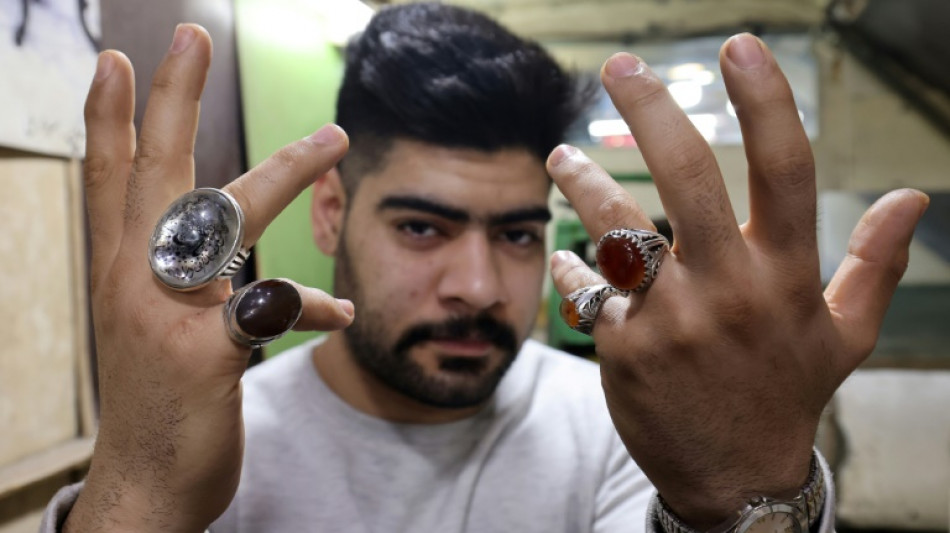
-
 Schools closed in Beirut after deadly Israeli strike
Schools closed in Beirut after deadly Israeli strike
-
Chris Wood hits hat-trick in NZ World Cup qualifying rout

-
 Markets mixed after Wall St losses as traders weigh US rates outlook
Markets mixed after Wall St losses as traders weigh US rates outlook
-
US, Philippines sign deal on sharing military information

-
 Bangladeshi ex-ministers face 'massacre' charges in court
Bangladeshi ex-ministers face 'massacre' charges in court
-
Law and disorder as Thai police station comes under monkey attack

-
 Disgraced Singapore oil tycoon sentenced to nearly 18 years for fraud
Disgraced Singapore oil tycoon sentenced to nearly 18 years for fraud
-
Philippines cleans up as typhoon death toll rises

-
 Quincy Jones awarded posthumous Oscar
Quincy Jones awarded posthumous Oscar
-
'Critically endangered' African penguins just want peace and food

-
 Long delayed Ukrainian survival video game sequel set for release amid war
Long delayed Ukrainian survival video game sequel set for release amid war
-
Star Australian broadcaster charged with sex offences

-
 Philippines cleans up after sixth major storm in weeks
Philippines cleans up after sixth major storm in weeks
-
Woman-owned cafe in Indonesia's Sharia stronghold shakes stigma

-
 Indigenous Australian lawmaker who heckled King Charles censured
Indigenous Australian lawmaker who heckled King Charles censured
-
End of an era as Nadal aims for winning Davis Cup farewell

-
 Trump taps big tech critic Carr to lead US communications agency
Trump taps big tech critic Carr to lead US communications agency
-
Mitchell-less Cavs rip Hornets as perfect NBA start hits 15-0

-
 Markets swing after Wall St losses as traders weigh US rates outlook
Markets swing after Wall St losses as traders weigh US rates outlook
-
India's capital shuts schools because of smog

-
 Rio under high security for G20 summit
Rio under high security for G20 summit
-
G20 leaders to grapple with climate, taxes, Trump comeback

-
 Hopes set on G20 spurring deadlocked UN climate talks
Hopes set on G20 spurring deadlocked UN climate talks
-
Gabon early results show voters back new constitution

-
 Child abuse police arrest star Australian broadcaster
Child abuse police arrest star Australian broadcaster
-
Disgraced Singapore oil tycoon to be sentenced for fraud

-
 Stray dogs in Giza become tourist draw after 'pyramid puppy' sensation
Stray dogs in Giza become tourist draw after 'pyramid puppy' sensation
-
UN Security Council to weigh call for immediate Sudan ceasefire

-
 Is AI's meteoric rise beginning to slow?
Is AI's meteoric rise beginning to slow?
-
Israeli strikes on Beirut kill six, including Hezbollah official

-
 Rain wipes out England's final T20 in West Indies
Rain wipes out England's final T20 in West Indies
-
US speaker opposes calls to release ethics report on Trump's AG pick

-
 McDonald's feast undercuts Trump health pledge
McDonald's feast undercuts Trump health pledge
-
Thousands march through Athens to mark student uprising

-
 NBA fines Hornets' Ball, T-Wolves' Edwards, Bucks coach Rivers
NBA fines Hornets' Ball, T-Wolves' Edwards, Bucks coach Rivers
-
China's Xi says to 'enhance' ties with Brazil as arrives for G20: state media

-
 Bills snap nine-game Chiefs win streak to spoil perfect NFL start
Bills snap nine-game Chiefs win streak to spoil perfect NFL start
-
Biden answers missile pleas from Ukraine as clock ticks down

-
 Senegal ruling party claims 'large victory' in elections
Senegal ruling party claims 'large victory' in elections
-
Dutch plan 'nice adios' for Nadal at Davis Cup retirement party

-
 Trump meets PGA boss and Saudi PIF head amid deal talks: report
Trump meets PGA boss and Saudi PIF head amid deal talks: report
-
UN chief urges G20 'leadership' on stalled climate talks

-
 Steelers edge Ravens, Lions maul Jaguars
Steelers edge Ravens, Lions maul Jaguars
-
No.1 Korda wins LPGA Annika for seventh title of the season

-
 Biden touts climate legacy in landmark Amazon visit
Biden touts climate legacy in landmark Amazon visit
-
England secure Nations League promotion, France beat Italy

-
 Star power fails to perk up France's premiere wine auction
Star power fails to perk up France's premiere wine auction
-
Rabiot brace fires France past Italy and top of Nations League group

-
 Carsley relieved to sign off with Nations League promotion for England
Carsley relieved to sign off with Nations League promotion for England
-
Sinner says room to improve in 2025 after home ATP Finals triumph


Iran's long-lasting love for gemstones
At a prominent Shiite shrine in southern Tehran, Qasem Ashgari was buying yet another gemstone ring in the hope it would help his prayers to be answered promptly.
Asghari, in his 30s, who was already wearing several bands on each hand, had a specific ring in mind: a silver one, adorned with yellow agate and engraved with religious scripts.
"The reward of one prayer is multiplied... if done with an agate ring," he told AFP while strolling through the meandering alleys of the market near the shrine of Shah Abdolazim.
Asghari's appreciation for gemstones is shared by many Shiite Muslims in Iran, where prominent male scholars and senior officials are often seen publicly sporting similar rings.
Many in the Shiite-majority country attribute high religious significance to gemstones, which they view as a way to ensure divine protection, ward off evil, and prevent poverty.
Common beliefs associated with gemstones are largely what motivates people to buy them, said Hassan Samimi, a lapidary at the market.
"It is very rare to find someone who wears a ring just for its beauty," said Samimi, 52, in his workshop where he carves large uncut gemstones for rings, necklaces, prayer beads and other items.
- Agate and turquoise -
Inside, one customer, Maryam, browsed through a collection of rings bearing agate, turquoise, topaz, lapis lazuli, emeralds and other stones.
"I get a good feeling from these stones," said the 50-year-old teacher after picking a turquoise set comprising a ring, earrings, and a bracelet.
Samimi says his sales were mostly from agate and turquoise, the most revered stones, especially among Iran's religious community.
Turquoise has been mined in the country since the times of ancient Persia, with Iran home to one of the oldest such mines in the world.
Its bluish-green colour has inspired artists over the years and features prominently in Persian monuments and artefacts as well as Islamic architecture.
The turquoise from the eastern city of Neyshabur "is the most expensive", said Samimi. "The smoother and bluer the turquoise is, the higher its price is."
Hamid Rashidi, another craftsman, says the stone is generally affordable but depending on the quality a piece could sell for as much as four billion rials ($6,000-7,000).
Many Iranians believe it attracts wealth to the bearer and sometimes cite the religious saying "the hand that wears turquoise... will never see poverty".
It is also believed "to enhance eyesight and calm the nerves", said Samimi.
Agate, especially from Yemen, is also popular "because it is recommended by imams" who often claim it can boost livelihoods, said Rashidi.
- 'Cultural heritage' -
Iran's senior officials including Ayatollah Ali Khamenei have often been spotted wearing rings with agate or turquoise stones and the supreme leader has been known to gift them as tokens of his appreciation.
The body of the revered Revolutionary Guards commander Qasem Soleimani, who was killed in a 2020 US strike in Baghdad, was in part identified by the agate ring he wore.
Iran subsequently declared the ring "cultural heritage" and a "national asset".
Samimi says demand for gemstones has remained relatively steady despite Iran's severe economic challenges.
Inflation in the country has in recent years hovered near 50 percent while the rial has sharply declined against the dollar.
"The stones market has become much better" over the years, he said, adding that there had been a significant increase in the number of craftsmen in the market compared with nearly three decades ago.
Its continued success, however, may hang on evolving tastes. Samimi admitted that agate and turquoise are not popular among younger generations.
"Young people mostly buy rubies and emeralds and birthstones," he said.
"For them, they are more fashionable."
J.Gomez--AT


